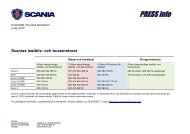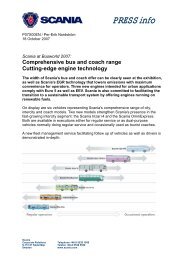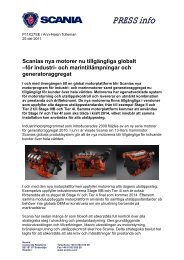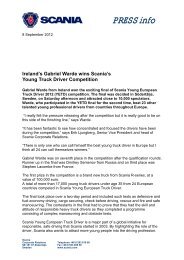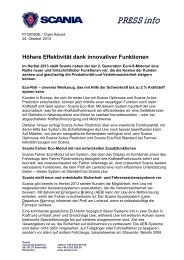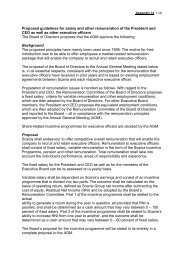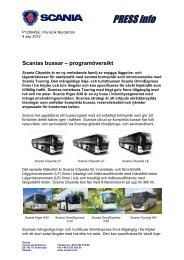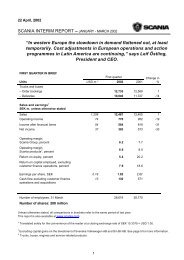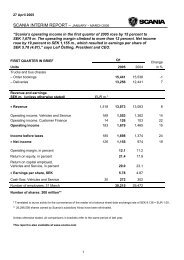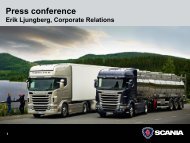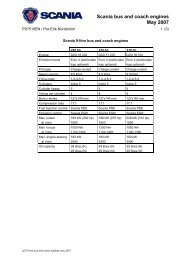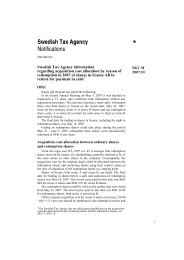Scania annual report 2004
Scania annual report 2004
Scania annual report 2004
Create successful ePaper yourself
Turn your PDF publications into a flip-book with our unique Google optimized e-Paper software.
Attacking environmental<br />
impact at the source<br />
<strong>Scania</strong>’s guiding principle is to reduce the environmental impact in all stages of a<br />
product’s life cycle. Clean technology is the key to good environmental performance,<br />
both for the company’s products and at its production and service facilities.<br />
New Environmental Policy<br />
<strong>Scania</strong>’s Environmental Policy and overall<br />
environmental objectives state the positions<br />
that are shared by the entire company.<br />
During <strong>2004</strong>, the Environmental Policy<br />
was revised to better support <strong>Scania</strong>’s<br />
operations. The new Environmental Policy<br />
makes it clear that the environment is an<br />
integral part of <strong>Scania</strong>’s business priorities.<br />
The relationship between environmental<br />
work and the principle of precaution has<br />
been clarified, which is a natural consequence<br />
of <strong>Scania</strong>’s support of the OECD<br />
Guidelines for Multinational Enterprises.<br />
According to the principle of precaution,<br />
precautionary measures shall be undertaken<br />
when there is reason to assume that<br />
an action may harm human health or the<br />
environment.<br />
A shared concern<br />
Environmental work is integrated into<br />
<strong>Scania</strong>’s operations. A survey conducted<br />
during <strong>2004</strong> shows that most <strong>Scania</strong><br />
employees feel they are involved in this<br />
environmental work.<br />
The highest decision-making body for<br />
environmental issues is the <strong>Scania</strong> Executive<br />
Board, which makes strategic decisions.<br />
Common day-to-day environmental items<br />
of business are prepared by the <strong>Scania</strong><br />
Environmental Committee, where environmental<br />
coordinators from various fields of<br />
operations meet under the leadership of<br />
the Quality and Environment department.<br />
Operational decisions are made in the<br />
line organisation, where all managers have<br />
environmental responsibility for their respective<br />
areas. Local management teams<br />
are responsible for targets and follow-up<br />
at the local level.<br />
The environmental management system<br />
All production units are certified according<br />
to the ISO 14001 environmental management<br />
system.<br />
Corporate departments, such as Group<br />
Management, procurement and product<br />
development units, are certified. Environmental<br />
management procedures are<br />
integrated into <strong>Scania</strong>’s management<br />
system.<br />
Emission allowances<br />
Now that the Kyoto Protocol has entered<br />
into force, the EU countries must jointly<br />
reduce carbon dioxide emissions by eight<br />
percent during the period 2008 to 2012,<br />
with 1990 as the base year. Trading in<br />
emission allowances, which begins in<br />
2005, is one means of achieving this<br />
reduction. Transport services are not<br />
included in the scheme.<br />
<strong>Scania</strong>’s energy supply units in Oskarshamn<br />
and Södertälje, Sweden are included<br />
in the trading scheme. One effect of the<br />
recently completed expansion of operations<br />
in Oskarshamn is that <strong>Scania</strong> needs<br />
to buy emission allowances, estimated at<br />
4,000, beginning in 2005.<br />
Environmental adaptation of products<br />
Taking environmental aspects into account<br />
at an early stage of product development<br />
makes it possible to minimise the environmental<br />
impact of a product throughout its<br />
life cycle. <strong>Scania</strong> attaches great importance<br />
to designing a vehicle to reduce the environmental<br />
load that arises while the vehicle<br />
is in use. Aside from <strong>Scania</strong>’s internal<br />
development targets, future legal requirements<br />
weigh heavily in development work.<br />
Among strategic fields for the environmental<br />
performance of a product are<br />
emissions of fossil carbon dioxide and<br />
other exhaust gas components, chemical<br />
content and the end-of-life treatment of<br />
worn-out vehicles.<br />
<strong>Scania</strong> as a customer<br />
<strong>Scania</strong> buys materials and components<br />
from suppliers. It is important that the<br />
actions of suppliers are consistent with<br />
<strong>Scania</strong>’s environmental approach.<br />
Regardless of where a supplier is<br />
located, <strong>Scania</strong> requires ISO 14001 certification.<br />
<strong>Scania</strong> surveys suppliers’ environmental<br />
work by using an Environmental<br />
Self Assessment and recurring follow-ups.<br />
Collaboration on environmental issues<br />
leads to continuous improvements and<br />
helps improve expertise and enhance<br />
environmental awareness among suppliers.<br />
THE ENVIRONMENT • SCANIA ANNUAL REPORT <strong>2004</strong> 18



